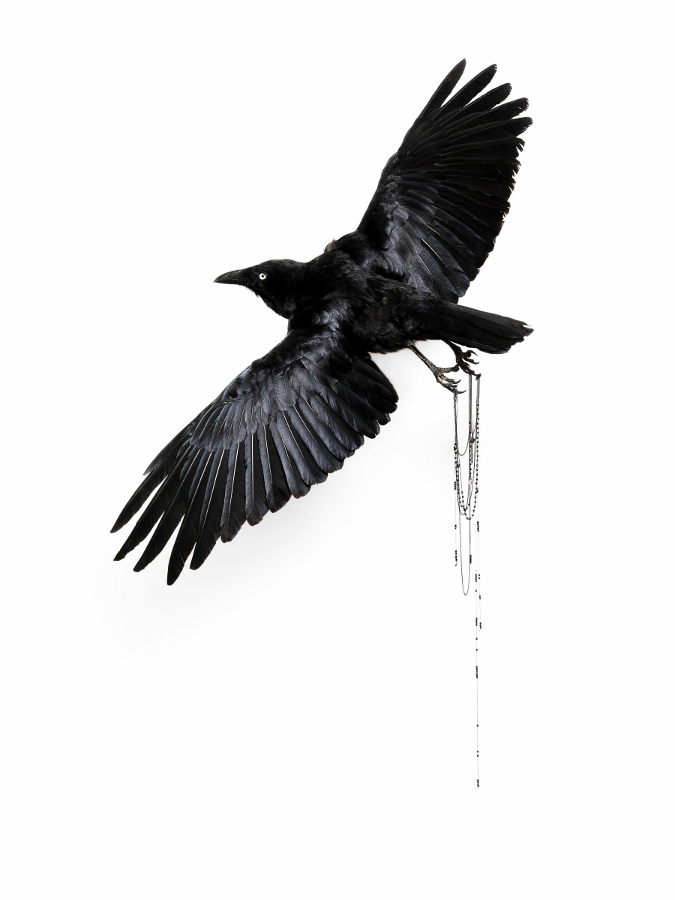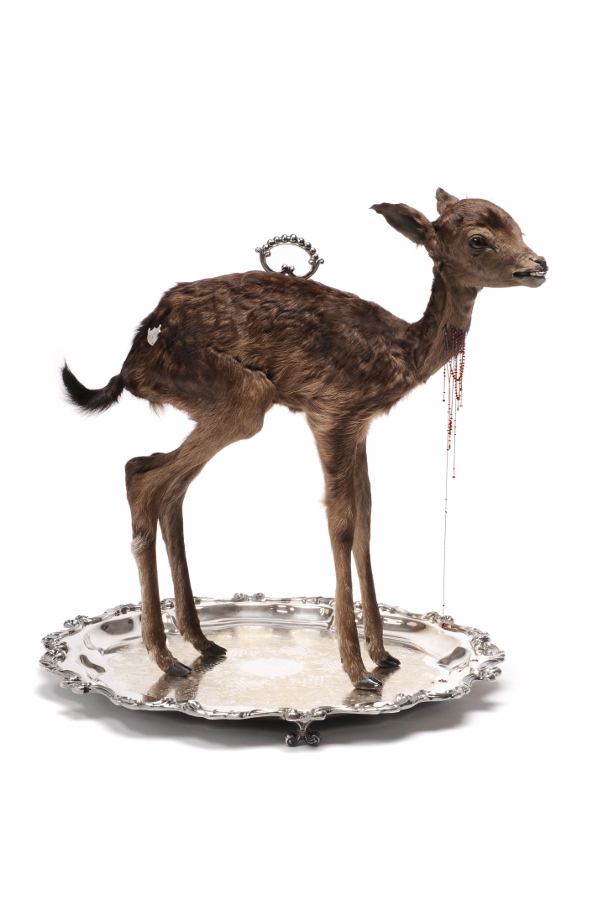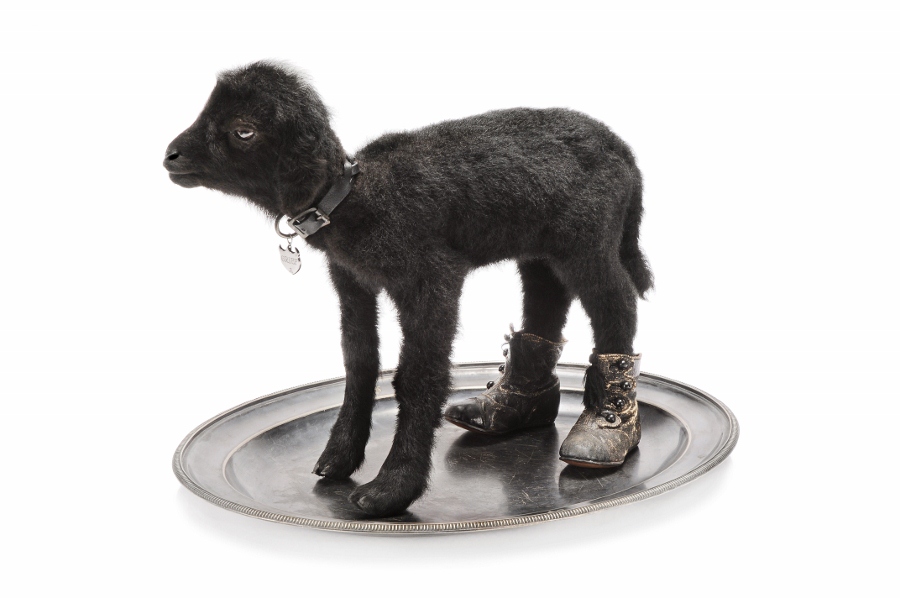How to Live & How to Die with Jewelry & Taxidermy Artist Julia deVille

Creativity arises where polarities co-exist. The art of Julia deVille exists in the space between extremes. A vegetarian whose art is taxidermied animals. Conscious of being an animal rights activist through her art, deVille does this through one of the most potent channels. Emotion. The power of deVille’s art lies in its simultaneous seduction and kick in the gut. It works on us in a visceral and primal way, reaching past taboos and politics to tug on our hearts, our desires and shock and cajole us out of complacency. Then it invites us to think. Claire Bridge spoke recently with Julia for Art World Women about jewelry making, taxidermy, how to live and of course, how to die.
above: Julia deVille, Night’s Plutonian Shore, 2009, Tasmanian Forest Raven, black garnets, cotton, sterling silver, amethyst, 100 x 50 x 80 cm
AWW: “Disce Mori” – what does the expression “Learn to die” mean to you? How does it apply to your art and your everyday?
JdV: To me learning to die means accepting my own mortality. I believe if we can acknowledge the imminence of death, we can in turn, appreciate the significance of life.
AWW: There is a dark elegance in your work, a sweetness, an innocence, a beauty and lingering resonance of melancholia. What attracts you to these qualities and how do you see them in relation to your work?
JdV: I try to portray the innocence and beauty of the animals I work on. I want to celebrate their lives. I guess this is also a metaphor for life. Life is fragile and beautiful and innocent. It can also be dark and brutal.
AWW: What drew you to taxidermy?
JdV: I’ve been interested in it from the day I first realized it was something you could do. I have no idea why I’m so drawn to it because the attraction came long before I had formed my sense of self.

AWW: How do you source the animals and birds that become part of your works?
JdV: All animals have died of natural causes. I have a lot of farmer contacts that donate stillborns etc to me as well as people that know my work donating things they find.
AWW: Why do birds and feathers feature so frequently in your work? What is it about birds that interests you?
JdV: It’s all about supply. I use what I get given or find myself. Birds are most common, however my last show was predominately farm animals (lambs, deer, calves etc).
AWW: Infant new borns, lambs, kittens, puppies and fluffy chicks are used in your work. This juxtaposition of youth and innocence with the reality of death confronts in a visceral way. What are your thoughts about the contrast?
JdV: Again, this is about the fleeting nature of life. There is something so pure and innocent about a stillborn animal. The hold the fragility that I am trying to express. To me, death and life are one so it’s not really a juxtaposition. It just is.

AWW: You seem to have the complete package going on. A creative oeuvre that ranges from jewelry making, to taxidermy, accessories, furs, gloves, even boots! How do you manage to do so much and keep all these aspects of your art practice and business moving along?
JdV: Well, I actually don’t do the leatherwork anymore for ethical reasons (I just haven’t had time to update my website). I have three assistants that make most of the jewellery for me and I make the art works and engagement rings. I work a lot – often seven days a week. I could work every waking second of my life and still not complete all my ideas but I’m learning that having a life is important too. I’m trying to focus more on that now to bring in some balance.
AWW: Your taxidermied animals and some of your accessories or jewellery pieces could be seen as an objectification of the animal that becomes your art. As a strict vegetarian and someone who believes strongly in the just treatment of animals, how do you respond to this perception? How do you see your work in relation to the wearing furs or skins made from farmed or hunted animals?
JdV: My work is recycling. The animals I use are already dead so I see no harm in using their bodies for art. In fact, most of my work carries a strong animal rights theme. My aim is to change the way our society uses animals as a commodity. We need to start treating them as living sentient beings.
I will not however buy leather or fur new as this goes against my belief. I wear vintage leather and fur because again, it is recycling.
AWW: I heard a rumour that there might be a Clydesdale horse about to receive the JdV treatment. Can you give us a glimpse into what your plans are for such a large work?
JdV: I’m just doing a head mount as there is no one in Australia that can tan a full Clydesdale. I am going to use it for a collaboration with Leslie Rice – I will do mount the head and shoulders and Leslie will paint wings behind it on black velvet. Pegasus.
AWW: Which women artists inspire you?
JdV: I love Patricia Piccinini. She is my favourite female artist a dear friend too. I also love Del Kathryn Barton’s work.
AWW: Who have been the influential/inspirational women in your life?
JdV: My Mother is the most inspirational woman I have ever met. She is god to me.
AWW: If you could only keep one piece of all the artwork you have made to date (including works you may no longer have), firstly would you keep it and if so, which piece would it be and why?
JdV: A raven (titled, Night’s Plutonian Shore) that I did for my first show at Sophie Gannon Gallery. It is on my bedroom wall. Raven is one of my animal totems and they have a very powerful symbology.
AWW: What is death?
JdV: There is no such thing in reality. It is a construct of the human ego. It is just part of the cycle of life.
AWW: What does it mean to you to be ‘present’ in the moment?
JdV: Exactly that, letting go of the past and future. Most of us (including me) are consumed by thought and spend very little time living our lives as they happen. I meditate daily to try and bring more presence into my life. My work is a meditation too.
AWW: Meditation, yes, many artists work with meditation as part of their practice. What is your experience of meditation in relation to your art practice?
JdV: When I work, it is the only thing in my life that feels 100% natural. I was told by an astrologer that I have resolved creativity in a past life and now it just flows through me. I guess this is why working for me is meditation. There is no resistance or blockages. When I make my work, I know it’s what I’m meant to do. There is no doubt. The feeling is being in the moment totally, without having to try. It just happens. It’s freedom for me.

AWW: What does “equality” for women look like for you?
JdV: I think equality means living out our true expression of self. Stripping back societies views on how we should behave (whether it is the feminist model or any other), and expressing our own individual nature. I think meditation and self discovery is the best way to achieve this. Looking within, instead of looking outward.
AWW: What does the fair and just treatment of animals look like for you? How would the world be different?
JdV: We wouldn’t eat animals. We definitely wouldn’t put them in factory farms or treat them in ways that are intuitively cruel. All animals would be protected by the same laws that protect our pets from cruelty.
AWW: What materials do you most enjoy working with?
JdV: Definitely my animals.
AWW: Is there anything you would not taxidermy?
JdV: Fish and lizards as it is a different process that I can’t do.
AWW: What is a favourite object that you have in your studio?
JdV: My two dogs – I far prefer my live animals to my dead ones.
AWW: In which aspect of your practice do you feel most in the flow?
JdV: My taxidermy sculptural work. It is pure creativity for me. I love making jewellery but I often feel compromised by the issue of wearability.
AWW: What are you working on now?
JdV: This time of year is jewellery making – I’m getting my Xmas orders out until 24th December.
AWW: What’s next for you?
JdV: I’m showing with Leslie Rice at Jan Murphy Gallery (Brisbane) in July 2013 and then I’ll have another solo show in July 2014 at Sophie Gannon Gallery.
Julia deVille Website: www.discemori.com
Julia deVille is represented by Sophie Gannon Gallery, Melbourne
1 thought on “How to Live & How to Die with Jewelry & Taxidermy Artist Julia deVille”